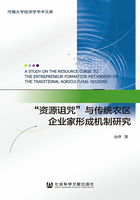
ABSTRACT
The traditional view of development economics is that capital formation was regarded as a key factor for an agricultural society's industrialization. Accordingly, we can get the following corollary: the regions with poor agricultural production conditions were more difficult for capital accumulation and starting industrialization progress than the regions with better agricultural production conditions. However, the paper has observed the opposite cases that compared with their neighbors, some regions with better agricultural production conditions have lagged behind in economy development and industrialization. This paper argues that agricultural production conditions have not only a positive effect of capital formation which benefit industrialization, but also an inhibitory effect of entrepreneurship. The paper defined the inhibitory effect as “resource curse of agricultural production conditions”.
The resource curse formed by agricultural production conditions is a trap to prevent the agricultural regions from starting their industrialization. Based on the literature review in chapter 2, the paper has proposed a hypothesis to explain the mechanism of the “resource curse”: endowment differences in agricultural production conditions have caused a selection effect on residents' choice of career. In the region with better agricultural production conditions, the residents tend to choose farming as their occupation because of the steady return, which is not conducive to the production of entrepreneurs as well as the course of industrialization. To test the hypothesis, the paper has made an empirical research by using the local economic data of 18 districts in Henan province though 13 years. And,the results lend their support to the hypothesis. Moreover, the effect of agricultur al production conditions to entrepreneurship is nonlinear, which can be described as a U-shaped curve. So, the particular “resource curse” occurs conditionally. It can be found only in the areas with better agricultural production conditions and low income. The results of empirical research also show the comparative advantage in agriculture may produce a “crowding out” effect. Business cycle and financial developments will produce a non-linear effect on entrepreneurship. And,the comparative advantage in agriculture will restrict the positive impact on entrepreneurship produced by financial development and business prosperity. In addition, the results of the study have implied that the increments of formal financial institutions and private finance were contrary.
The results of empirical research have supported the hypothesis presented in this paper, but it still needs a theoretical explanation to clarify the mechanism of the “resource curse”. In chapter 4, the paper constructs a career choice model to explain the mechanism. The model has pointed out that differences in agricultural production conditions lead to different farming income, which is the opportunity cost of entrepreneurial activity. Better conditions for agricultural production mean higher opportunity cost of entrepreneurial activity, and thus the higher opportunity cost suppressing entrepreneurial activity with high risks. Meanwhile, the theoretical model has depicted the necessary conditions for “resource curse”. Firstly, the restricted financing capacity is an important condition of “resource curse”. Under the situation of financial repression, the restricted financing capacity has limited the scales and returns of entrepreneurial activities. Without the financial repression, the returns of entrepreneurial activities will be higher and the opportunity cost will no longer be important, so there will be no such “resource curse”. Secondly, the restricted labor mobility is another important condition of “resource curse”. At the beginning of China's reform and opening up, rural residents didn't have enough opportunities to get a non-agriculture job. It is the reason that led to the opportunity cost of entrepreneurial activity determined by the agricultural production conditions, thus forming the “resource curse” phenomenon of the traditional agricultural regions. If the labors can go to urban areas and seek jobs offered by manufacturing or serv ices sectors which provide higher salaries, the opportunity cost of entrepreneurial activity will no longer be measured by the agricultural production conditions. And, there will not be the “resource curse”phenomenon. Thirdly, the presupposition, the rural residents' preference for consumption and saving should have quasi-linear characteristics, is necessary. The explanation of the “resource curse” model depends on the rural residents' incremental saving function,which is based on quasi-linear preference. The presupposition has consisted with Engel's law which is used frequently to describe the low-income consumer's behavior, and corresponded to Rostovian take-off model. Fourthly, low degree of market integration is also one of the conditions of “resource curse”. If the market is well-integrated, then entrepreneurs may seek investment opportunities in the whole market instead of the local investment opportunities. Thus, the “resource curse” phenomenon is limited to the specific conditions. As the degree of market integration improved, the better resource regions will get better development and investment opportunities, and then the “resource curse” phenomenon will no longer exist.
In the new economic and social environment, industrial shift presents a new approach to industrialization for the traditional agricultural regions. Industrial shift also changes the entrepreneurs' formation and development mechanism. The factors of macroeconomic environment will play a key role in the entrepreneurs' formation and development.
Finally, the paper has drawn the conclusions of the study. On the basis of summarizing the innovations and deficiency of the study, the paper also points out the direction of the successive research such as: expanding data from cross-sectional and time-series to make the empirical research better; introducing institutional and cultural variables to the model to control their disturbance to the Regression Analysis; considering the inter-regional flow of the product factors to make the research describing real-life better; testing the new hypotheses provided by the paper such as “crowding out” effect between the private finance sector and the formal finance sector or “agricultural comparative advantage trap”; dynamiting the theoretical model so that the content can explain the industrialized pro gress of the undeveloped regions in the sense of dynamic general equilibrium without limited to comparative static analysis.
KEY WORDS: Resource Curse, Entrepreneur, Traditional Agricultural Regions, Industrialization